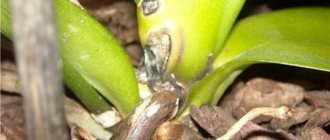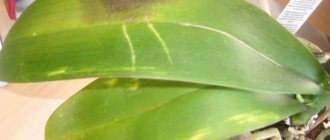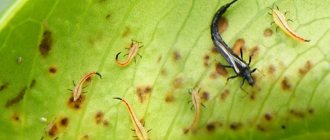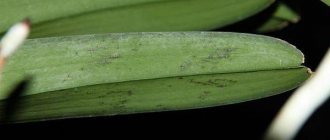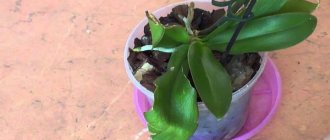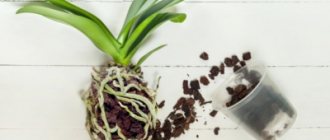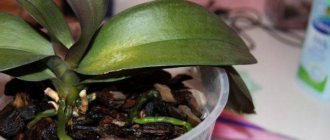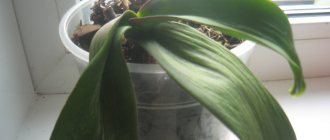There are sticky drops on the orchid leaves, what should I do?
There are many reasons for the appearance of sticky drops on the leaves of the phalaenopsis orchid and other types of orchids. The most common include pest damage or disease. This may also be due to improper care of the flower.
Natural process
In a plant crop, the process of moisture movement throughout the plant occurs regularly; flower growers call it transpiration. During this process, evaporation is formed in the form of droplets on the leaves. This phenomenon in itself is safe and does not pose any threat to the full development of the orchid. However, the following negative consequences may occur:
- the appearance of ants that gather for sweet nectar;
- appearance of various insects.
In most cases, pests stick to the sticky droplets and die. Many of them are put off by the overly sweet smell.
Excessive watering
The formation of sticky drops on orchid leaves can also be a consequence of improper care. If you irrigate a plant too often or abundantly, excess liquid accumulates on its green mass, gradually this substance becomes sticky.
Excess moisture that has accumulated in the pan also evaporates and settles on the leaves of color. All this negatively affects the condition of the plant - it begins to wither and fade. Therefore, the watering regime should be normalized.
On a note! During the active growth phase, it is recommended to irrigate Phalaenopsis once every 5-7 days, and during flowering and during the dormant period once every 8-10 days.
Excess fertilizing
Due to excessive fertilization, the orchid's metabolism increases significantly. As a result, internal nectar begins to be actively released, which subsequently settles in the form of sticky droplets. Overfeeding leads to the following negative consequences:
- phosphorus;
- potassium;
- nitrogen.
In the future, the plant crop will begin to fade. The leaves will dry out and spots will form on them. To save it from death, you need to completely replace the soil in the pot and give it a break from fertilizers for a while.
Pest infestation
One of the most common reasons why sticky drops form on orchid leaves is pest damage. Most dangerous for the orchid:
Shield. After defeating a plant, this insect creates a dome of wax above itself. It is often confused with sticky droplets. But, if you look closely, you will notice traces of damage in the form of small holes.
Scaleworms. When eaten, this type of pest sucks out the inner juice from the leaves, then injects its poison there. In appearance, they look like small white lumps with a waxy surface. It is for this reason that it is quite easy to confuse it with sticky droplets.
Spider mite. Due to the infestation of this insect, a white coating forms on the leaves, which subsequently condenses into moisture.
If pests have formed on the surface of the green mass of the orchid, immediate measures must be taken to eliminate them. Otherwise, the plant crop may die.
Powdery mildew
The most common disease to which Phalaenopsis is susceptible is powdery mildew. It can be recognized by several characteristic features:
- the appearance of multiple small sticky droplets;
- the formation of white plaque, which subsequently darkens;
- drying of damaged areas.
In most cases, powdery mildew is a consequence of high levels of humidity and temperature in the room, and excessive watering. If you do not start treating the disease in a timely manner, the plant will die.
What it is?
Indeed, sugar droplets can often be seen on the leaves of orchids . And they are found not only in indoor varieties, but also in wild flowers. The scientific name for this phenomenon is transpiration. The substance looks like dew drops, but if you look closely, you can see a sugary structure. They feel sticky to the touch and taste like sweet drops.
Attention : Extrafloral nectar may be physiological in nature, in which case it does not pose any threat to the plant.
How to identify the cause?
The first thing to do is to identify the cause of the formation of sticky plaque on the orchid leaves. Based on this, you can choose the most suitable method to solve the problem.
Signs of a natural process
If the droplets appeared as a result of natural movement and evaporation of moisture, then there should be no associated symptoms of the disease or signs of damage. No special actions are required, you just need to normalize the watering regime and monitor the condition of the plant.
Signs of improper care
The reasons why the orchid’s leaves have become sticky include violations of the rules for caring for it, namely:
- increased or decreased humidity level in the room where the flower grows;
- any draft near the plant - an open window or front door;
- low air temperature;
- improper lighting - too bright or, on the contrary, insufficient.
In addition to the formation of moisture, signs of violation of plant growing conditions include:
- slow development;
- lack of flowering;
- wilting of leaves;
- the appearance of a light coating.
The problem can be corrected by normalizing the care and watering regime.
On a note! The optimal air temperature for growing orchids is from 18 to 25 degrees Celsius. However, when flowering or during a period of active growth, it needs coolness, so the optimal air temperature should be from 12 to 16 degrees.
Signs of a pest infestation
You can recognize that a plant crop has been damaged by pests by several characteristic symptoms:
- sticky drops;
- white coating;
- traces of eating;
- wilting of leaves.
At first glance, these sticky drops can be confused with insect pests. They can only be recognized with a magnifying glass.
Why are the leaves sticky on the bottom?
If sticky drops appear on the underside of the orchid leaves, the reason may be due to the appearance of aphids. Most often, they colonize the back side of the green mass, and when infected, they secrete a characteristic sugary liquid.
Where can transparent droplets appear?
Viscous transparent droplets can form on different parts of the plant:
- on leaves;
- flower shoot;
- Bulbach.
On the leaves
The appearance of drops on the underside of a leaf is not always a cause for concern. This may be a natural process of transpiration. The occurrence of infection or parasites is indicated by the simultaneous presence of plaque or spots. There are also parasitic insects that leave a shiny sticky trail (aphids, mealyworms, copperheads). Still, it’s worth making sure the tropical flower is healthy and preventing infection.
On the peduncle
Sticky moisture on a flower shoot signals improper care and an unsuitable microclimate for the plant. Here the drops are more difficult to notice; they look like water that accidentally fell on the peduncle. However, you should not miss this sign. Errors in care weaken the orchid’s immunity and lead to the development of diseases. If drops are detected, excessive watering and high humidity should be immediately avoided.
On the bulbs
The body of Phalaenopsis is called bulbs. The appearance of sweet drops on these parts of the plant may indicate improper watering or the presence of pests. Here it is immediately clear that the orchid is in danger. The owner should immediately begin taking measures to save the flower.
How to eliminate the consequences of improper care?
A frequently asked question is what to do if there are sticky droplets on the orchid? Experienced flower growers recommend, first of all, neutralizing the consequences of improper plant care. You can do this as follows:
- It is necessary to rinse the leaves with running water. If possible, rinse the pot and change the soil. After this, it is necessary to reduce the amount of irrigation if the soil was previously waterlogged.
- If there is a low level of humidity in the room, most often this is observed in the summer season, it is recommended to spray with warm water with the addition of a few drops of fungicide.
- Normalize the lighting mode. It is better to grow an orchid on a windowsill, but at the same time it should not be exposed to direct sunlight. It is also necessary to avoid drafts.
If the appearance of a sticky coating is a consequence of improper care, it must be eliminated. To do this, it is enough to treat the plant with warm or hot water from the shower. Firstly, during this procedure it will be possible to get rid of sticky drops. Secondly, it will be possible to prevent stagnation of moisture in the axils of the leaves.
How to treat stickiness
The course of further action depends on the root cause.
If these are errors in care, then an immediate transplant of the orchid and normalization of living conditions is required. If the reason is pests and infections, then you can’t get by with handy means; you need to treat the orchid with industrial preparations or soapy water with tobacco.
Methods of treating plants depending on the cause
Treatment for sticky orchid leaves depends on the cause of their appearance. If it is associated with insect damage, then the following must be done:
- Place the Phalaenopsis pot away from other plants to prevent the risk of infection.
- Carefully remove pests. You can use a soft cloth or cotton swab for this purpose.
- If the leaves are severely affected, they should be cut off.
- Pass a piece of soap through a grater or divide it into small pieces. Dilute it in warm water and stir until a homogeneous consistency is formed. Rinse the plant with the resulting solution, including those areas where there are no traces of eating by insects.
If the flower is severely affected, then it must be treated with a special insecticide solution. You can buy it in stores for summer residents and gardeners. It is recommended to dilute in accordance with the instructions.
What to do if sticky drops and white coating appear on the orchids? Flower growers claim that this is due to powdery mildew, so the treatment should look like this:
- It is necessary to place the flower in the bath and rinse it with warm water under running water or shower.
- Leave to dry for 12-14 hours.
- Treat with a fungicide solution. The most effective is "Aktar" or "Aktellik". It is necessary to prepare and apply it in accordance with the instructions.
- Disinfect the new container. Fill it with disinfected soil. Transplant a flower into it.
Immediately after transplanting, it is recommended to reduce the amount of watering to once every 5-8 days. It is also not recommended to apply fertilizers during the year.
It is important that after treatment the plant is quarantined away from other plant crops for another 2-3 weeks. Before moving it back, you need to make sure there are no pests or signs of disease.
On a note! If the formation of sticky plaque is natural, then there is no need to eliminate it.
Step-by-step instructions for treating the disease
So, when the cause of sticky drops has been established, you need to take decisive action.
Due to a drastic change in care
Plants do not like to be stressed . So it tries to pay attention.
Optimal indoor conditions play an important role, therefore:
- set comfortable temperature and humidity parameters in the room;
- reduce the amount of mineral fertilizers consumed;
- minimize watering in winter;
- avoid sudden changes in temperature and drafts;
- Move the pot with the flower to the sunny side, protecting it from direct rays.
If the plaque is caused by pests
The orchid produces sweet nectar to protect itself . And the insects stick to it and die. Or another example of self-defense in the form of a food chain: sticky drops attract aphids, and they, in turn, ants, which can easily cope with leaf cutters.
However, upon inspection, the sticky substance may turn out to be traces of harmful insects that settle on the back of the leaf and feed on the sap of the flower. As a result, phalaenopsis withers and dies.
It’s not difficult to deal with such a problem, the main thing is to recognize it in time . Help:
- remove the diseased plant from healthy ones;
- remove insects with a cotton swab;
- reduce watering during cold seasons;
- moisten the space around the flower;
- If necessary, trim the affected areas;
- wipe the leaves with a soap solution at room temperature;
- if soap does not help, the plant should be sprayed with an insecticide solution, the drugs Phosfamide, Fozalon, Nurell-D are suitable;
- Once every 10-14 days, the pot with the orchid should be immersed in water, after adding two Alirina-B tablets;
- Weekly preventive rinsing of the pot is important.
When the infectious threat has passed and the orchid feels good, it can be returned to its original place.
You can learn more about what diseases and pests can destroy phalaenopsis and how to save the plant in this article.
If stickiness is needed to attract pollinators
When the phalaenopsis looks good and, in general, there are no questions about its health, then sugar nectar is a natural process of the orchid’s life . In this case, it serves to attract pollinators.
There is nothing frightening about such an unusual phenomenon, and medical procedures should not be carried out. The only thing is that if the sticky layer spoils the appearance of the flower, it is washed off.
If the cause of plaque is an infection
A sweet substance is one of the symptoms of powdery mildew. Infectious disease in orchids develops quickly, so do not waste time. Help:
- isolate infected exotics;
- rinse the orchid with warm water;
- wait until it dries;
- treat the flower with Aktara and Actellik.
Advice : Before using chemicals, first treat with traditional methods.
Preventing sticky drops
It is impossible to prevent the appearance of a sticky coating on the leaves of orchids, since this is often a consequence of the natural internal movement of moisture. However, it is recommended to follow preventive measures that will avoid the appearance of unfavorable drops on the green mass, these include:
- Proper watering. You can tell that it’s time to moisturize by looking at the gray roots. Also, with a lack of moisture, condensation stops appearing on the inside of the pot. It is also worth considering that the liquid should be warm and soft.
- Choosing a location. The orchid should be exposed to diffused light. In the shade, the plant will not be able to grow fully, and exposure to the sun’s rays will cause burns on its green mass.
- Feeding. It is recommended to carry it out only during the vegetative growth of the plant crop. For this purpose, it is better to use specialized complex fertilizers suitable for a specific type of orchid.
You should also constantly monitor the appearance of the orchid. If signs of disease or pest damage appear, immediate measures must be taken to treat it.
Prevention methods
Sticky droplets , stains and the general appearance of sticking on the sheet plate require careful examination of the cause.
It’s good if this is a natural process that will not cause any significant harm to the orchid.
In other situations, you need to worry about finding the cause.
Check your exotic pets regularly. And if detected, immediately isolate and treat the flower.
that, with preventive treatment, will protect the orchid from the appearance of insect pests and will not allow the plant to be destroyed have a good effect
These drugs include:
- "Aktaru";
- "Aktellik";
- "Fitosporin".
“Fitosporin” is a good preventive biological product against powdery mildew.
You should avoid taking the plant to serious treatment. You need to be understanding about caring for it and avoid temperature changes , you need to maintain normal humidity and lighting.
Be careful about watering and carefully dose the fertilizer.
Features of caring for the affected plant
Treatment of sticky drops on orchid leaves also requires appropriate care, which boils down to the following:
- placing the plant crop in a quarantine zone for at least 2-3 weeks;
- treatment with soap solution or specialized preparations;
- creating optimal conditions for growth.
If the plant has been severely damaged, it is additionally recommended to feed it with a preparation such as Zircon or Epin.
Why might it appear?
There are many reasons for the appearance of a harmful white coating on an orchid. Most often the plant gets sick:
- with improper care;
- non-compliance with temperature conditions;
- improper watering.
It is also worth noting that the development of the disease may be a consequence of contamination of the substrate. So thorough disinfection of all tools and soil is a necessary condition for normal plant growth.
Improper care
These include many factors. Most often, the plant suffers in winter, since at this time the amount of natural light decreases, the air becomes drier, and water stagnates in the soil.
Common consequences of improper care are rotting of the root system and the formation of fungal plaque on the roots, leaves or stems. All this happens due to waterlogging of the soil.
As a result, the orchid:
- dies;
- attracts pests;
- rots, infecting the substrate.
Important! When watering, focus on the consistency of the soil in the pot, and not on the time interval between waterings. If the soil is dry enough, you can add a new portion of water.
Careful adherence to the watering regime must also be accompanied by strict adherence to the temperature regime, since mealybugs, which are dangerous for orchids, feel quite comfortable in a dry and warm place, but are afraid of moisture. To keep the roots healthy, but at the same time protect the leaves and stems from pests, wipe the leaf blades with a damp cloth and use spraying instead of watering.
The temperature in summer should remain within +18...+30 degrees, in winter +20...+23 degrees is sufficient. Air humidity should be at least 55%.
Timely removal of dried parts of the plant is also important. This helps protect the orchid from the spread of pests. Standard pruning is excellent prevention.
Infection in the soil
Sometimes the cause of orchid disease can be contaminated soil. That is why most flower growers advise purchasing ready-made soil mixtures only in trusted stores.
If you prefer to prepare the substrate yourself, be sure to disinfect:
- Take pre-prepared bark for the substrate.
- Dry the bark in the oven at +60 degrees for 15–20 minutes so that all possible pests and bacteria die.
- Disinfect the plant seedlings before planting them in sterile soil.
After replanting the plant, throw away the soil from under it, especially if the plant is sick with something. Do not replant other flowers in such soil under any circumstances, as there is a high risk of their infection and death.
Powdery mildew
This disease most often affects the leaf blades of orchids. Primary signs of the disease appear only in small areas. This is why most flower owners do not notice them. Over time, the affected area increases significantly.
The carrier of powdery mildew is powdery mycelium, which is capable of multiplying to incredible sizes in a short time under favorable environmental conditions. Outwardly, it looks like the surface of a sheet sprinkled with flour.
Causes of powdery mildew infection:
- sudden changes in temperature;
- waterlogging of the soil;
- lack of timely therapeutic or preventive measures.
Lack of treatment for such an infection leads to the death of the plant.
Mealybug
Mealybugs, otherwise called hairy lice or felt lice, belong to the family of hemipteran insects, which have nothing in common with the worms we are used to. Many inexperienced gardeners confuse scale insects with scale insects, although these insects are not even similar in appearance.
The mealybug has an oblong body 2–6 mm in length, beige or white in color. Their body is completely covered with a waxy coating, reminiscent of ordinary flour. They have bristles on the sides and two pairs of long hairs on the back.
There are many varieties of these pests in nature. Only three species pose a danger to orchids:
- Bristly. Their females have a red body tint, dusted with waxy “flour”. Males resemble flies in appearance and are capable of flight.
- Citrus. The body of females has a pinkish color and a light coating. They are the ones who leave sticky drops (sticky sweet secretion) on the surface of orchids. Males are brown in color and can fly.
- Seaside. The body of females is colored in gray-pink shades. Males have wings that allow them to fly from place to place.
Important! This type of pest can also reach the roots of the orchid. In addition, they secrete a special secretion that stimulates the formation of fungal infections and develops bacterial resistance to chemicals.
Fighting powdery mildew
If signs of powdery mildew appear, the treatment will be as follows:
- transfer the plant to another room;
- the flower is washed under running warm water or shower;
- dry for 12 hours;
- treated with fungicides Aktar or Aktellik;
- transplanted into a container with disinfected soil.
During the first period, reduce watering and do not fertilize the plant.
Preventive measures
To ensure protection against possible diseases, optimal conditions for keeping the orchid should be created. Prevention against infections:
- The substrate for planting orchids must be checked for the presence of insects and disinfected.
- In winter, it is necessary to maintain the temperature at +16...+18 °C, in summer +22...+25 °C.
- The humidity level should not exceed 60-70%.
- The room in which the plant is located must be constantly ventilated.
- The flower is watered 1-2 times every 10 days, the leaves are sprayed with water daily. The number of waterings is determined depending on the humidity of the substrate. Use separated water. Water should not be allowed to stagnate in the axils of the peduncles.
- During the flowering period, the orchid needs iron and potassium. It is fed 2 times every 30 days with fertilizer containing these minerals.
- Instead of fertilizers, you can use homemade vitamin cocktails. Thanks to them, the plant will begin to develop more actively and harmoniously. A cocktail containing B vitamins, glucose and succinic acid will make it easier to endure various diseases, unscheduled transplants and other difficulties.
If you constantly maintain the temperature at the desired level, avoiding sudden changes and drafts, and check the plant for pests, the flower will not need complex treatment. It is considered normal when sticky drops appear on the plant after each watering.
Previous
Why do orchid leaves turn yellow and what to do about it
Next
Why do orchid flowers and buds fall off?
How to get rid of white bugs?
To successfully destroy the bugs, you should follow the recommendations for exterminating the pest as accurately as possible, since this parasite is quite difficult to remove. There are several ways to destroy bugs.
Mechanical removal
To remove white bugs you need:
- To save a sick orchid, you must first move it to another room, since it can infect other plants.
- If several bugs were found, they should be removed with a cotton swab dipped in a soap solution, then carefully inspect and wash the leaves with soapy water.
- If the flower is very neglected, then you need to start cleaning it from old curled leaves. It is better to cut off the peduncle of a blooming orchid, so it will devote all its energy to fighting bugs, and not to flowering.
- The colony of bugs located at the growth point must be carefully removed with a cotton pad. If the pests remain in hard-to-reach places, they can be pulled out with tweezers.
- In some types of orchids, white bugs are able to get under the pseudobulb scales, so it is better to remove them completely. Do not be afraid to remove the old leaf - beetle larvae may be hiding under it, which will again crawl throughout the plant and form new colonies.
- After the visible signs of infection have been removed, the orchid should be treated with a warm solution of laundry soap and copper sulfate.
- If mealybugs have infested the roots of the flower, then replanting is required, completely replacing the old soil with new one. To do this, carefully remove the plant from the pot, remove old dried roots and soil, rinse thoroughly in running water and allow to dry for several hours. If the root was broken during the procedure, the broken area is sprinkled with cinnamon or brilliant green. Then you should carefully transplant the orchid into a new, proven substrate. After 2-3 days, the transplanted orchid is sprayed with an anti-pest product.
Folk remedies
In advanced cases, surface treatment is not enough, so you should take into account several folk remedies for the white bug:
- Spray with a mixture of water and oil. This requires 2 tbsp. Mix spoons of olive oil with 2 liters of water. The resulting emulsion is sprayed on the orchid 1-2 times a day.
- Garlic tincture. To do this, 4-5 chopped garlic cloves are poured into 0.5 liters of boiling water and allowed to brew for 4 hours. This decoction is used to wipe all parts of the plant.
- Alcohol soap solution. To 1 liter of settled water add 15 ml of ethyl alcohol and 1 tbsp. a spoonful of grated laundry soap, mix thoroughly and spray the plant after mechanical treatment once every 3 weeks for a month.
- Infusion of orange peels. 50 g of crushed orange peels are poured into 1 liter of boiling water and left for 24 hours. The solution is sprayed onto the leaves of the flower.
Use of chemicals
To combat insects, the chemical industry produces a huge amount of products. Their action is aimed at destroying pests through the intestines and respiratory system, some of them are capable of poisoning plant tissue for bugs, some act by contact method.
Since white bugs are well protected from the outside, it is better to use contact preparations with a large number of young animals that are not yet completely covered with plaque and are vulnerable. For better effect, combined or enteric-contact drugs are produced.
To remove the worm, the following drugs are suitable:
- Aktara;
- Biotlin;
- Spark "double effect";
- Confidor Extra;
- Bankol.
Preparations for combating mealybugs
When using chemicals, you should strictly adhere to the instructions for use, since some of them can harm the orchid if handled incorrectly. Do not neglect secondary treatment - bugs can acquire immunity to poison. The treatment is repeated after 1-2 weeks.

